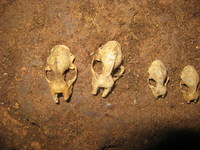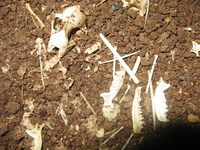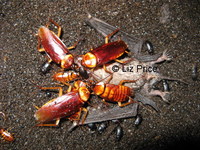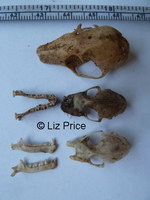|
Some bat fats
Bats are unique in the animal kingdom as they are the only mammals to have evolved true flight.
A baby bat weighs 25% of its mother's weight at birth.
Worldwide there are more than 1300 species of bats (Bat Con Int 2017). One third of those are listed on the IUCN Red List.
Indonesia has 175 species, the USA has about 40 species, England 18, and Malaysia has about 125 species. There are 110 species in Peninsular Malaysia (Lim et al).
This means Malaysia has roughly 10% of the world bat species. 70 species have been recorded in the Krau Wildlife Reserve in Pahang. It is home to the most diverse community of insectivorous bats in the world. 53 species have been recorded in just a 3 km2 area.
Bats are important for several reasons. The insectivorous bats help control the insect pests and can eat 50-100% of their body weight each night. This is good news for farmers, especially rice farmers as they eat rice pests.
Fruit eating bats are equally important as they help pollinate crops such as durain, banana and petai. 186 paleotropical plants rely on bats, these give 500 products which people use.
The large flying foxes roost in trees by the hundreds or thousands and feed on fruit and nectar. They are critical seed dispersers and pollinators, making them very important for rainforest propagation.
Geoffroy’s Rousette (Rousettus Amplexicaudatus) fruit bats are found in some Malaysian caves. The world’s largest colony according to Guinness World Records is found in the Monfort eco-tourism park in the Davao Region of the Philippines. The colony is estimated to be about 1.8 million, according to Bats Conservation International in 2006. They estimated the density as 60 bats per one square foot in the 300m long cave.
According to a David Attenborough programme, Conquest of the Skies, the oldest known bat fossil is 52 million years old.
Limestone habitats
Limestone areas support a wide variety of flora and fauna, and are important areas for biodiversity. However many karst areas are threatened by quarrying as well as by development. The tower karsts are mostly isolated, and with the increase in loss of natural habitat surrounding the hills, such as by agriculture or deforestation, each hill becomes an isolated island. For bats this means they may have to fly further to look for food.
Generally cave-roosting bats prefer to stay close to karst outcrops and caves. Conversely tree cavity/foliage-roosting bats are not so common around karst sites.
Struebig et al (2009) found at Gunung Senyum in Pahang that "of the 1962 insectivorous bats captured over the nine sites, 1080 individuals of 15 species, 99% of which are known to predominantly roost in caves".
Some tropical caves are home to huge colonies of bats. Deer Cave in Mulu is estimated to have more than 1 million. However Bracken Cave in Texas is home to the world’s largest bat colony, estimates are somewhere in the neighborhood of 20 million bats, Bat Conservation International (BCI).
Bats as food
In Malaysia I am not aware of microchiroptera being caught and eaten by humans, at least not on a large scale. However the large flying foxes (non cave) are hunted, either as food or because they eat fruit crops. Their numbers are also declining due to deforestation. In 2009 it was reported that the Pteropus vampyrus could become extinct in Peninsular Malaysia, as according to the US based Wildlife Trust, about 22,000 fruit bats are legally hunted each year in the peninsula. Taking into account those that are illegally hunted, this is probably an unsustainable level based on estimates of bats in the country. These bats can travel to Thailand and Indonesia.
During the Nipah virus outbreak in 1998-99 people were warned against eating bats. Little was heard of Nipah after that, until 2010 when the Star had 2 reports against eating bats, Warning to bat eaters and Batty food.
Bats as virus carriers
In 1998-9 many pigs in farms in Malaysia contracted a mystery virus which was also affecting the pig handlers. The virus was named Nipah after the place where it was first identified, in Negri Sembilan. Malaysian and international public-health authorities were able to control the virus. Pigs were culled and pig farms were closed or demolished.
In March 1999, Malaysian researcher Kaw Bing Chua identified the organism causing the disease it as a member of the paramyxovirus family. It seemed that the carrier was the flying fox, a large fruit bat of the genus Pteropus. These bats play a crucial role in maintaining tropical forests because they ingest and distribute the seeds of local trees. The fruit bats in the region were the only wildlife to test positive for the virus. It seems that with the ever increasing number of pig farms, the pigs and bats were coming into closer contact as some farms were built in areas of fruit trees.
Although the outbreak was contained in Malaysia, it surfaced in Bangladesh in 2001 and the Pteropus giganteus there were found to carry the Nipah virus. There were more outbreaks in 2003 and 2004.
According to the Wildlife Trust there are two species of flying fox native to Malaysia, and both these carry the Nipah virus. They are the Malayan flying fox (Pteropus vampyrus), and the Variable flying fox (Pteropus hypomelanus), also known as the island flying fox as it is found on Tioman.
In 2002-2003 there was an outbreak of severe acute respiratory syndrome (SARS) virus. It started in China and killed almost 800 people around the world. A similar virus was found in palm civets being sold in Guangdong’s animal markets. It was later found that similar viruses were in horseshoe bats (Rhinolophus) in China. After several years it was thought that bats in one cave in Yunnan were the carriers of SARS. See my blog Bats and SARS in China.
The cave food chain
Although bats are quite high up the food chain, when they die, they soon become food for countless other smaller creatures. In fact any animal that dies in a cave will soon be reduced to a bare skeleton by the scavengers.

bat skulls cleaned by scavengers |

3 sets of jaws close together suggest they've been dragged here by the predator |

cockroaches & beetles eating a dead bat |
IUCN Red List
The following Malaysian cave bats are on the IUCN Red List.
Nycteris tragata, Malayan Slit-faced Bat, listed as Near Threatened, due to significant deforestation. The type locality for this species is Bidi caves, Sarawak, but it is also found in other caves.

skulls from a Merapoh cave |
Protection for bats
In Malaysia there is little protection for cave bats, unless the cave is located within a protected area. This is very different from many temperate countries that have strict laws for protecting bats, especially those hibernating in the winter months. Heavy fines can be imposed for anyone harming or killing these bats. One notable case was in 2012 when Hollywood filmmakers were taken to court for disturbing bats in a Bulgarian cave.
Another possible threat to the bats is the extensive collection of their guano. An interesting paper from a study in Myanmar on whether guano collection is sustainable, 'Harvesting the guano of insectivorous bats: is it sustainable?' by Thet Thet & Khin Mya Mya, May 2015, see Journal of Threatened Taxa.

© Liz Price 2009-2017
Page updated Dec 2017
|
|